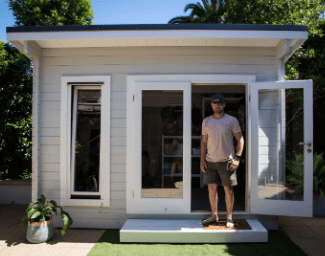Tiny Homes Are the Hot New Homeowners’ Accessory
The latest amenity for homeowners is another, smaller home.
These add-ons are known as accessory dwelling units. They can be free-standing miniature homes as small as a studio apartment and tucked away in a backyard. They can reside above a garage or in a basement and extend to more than 2,000 square feet.

“It’s gone from a small niche in the market to really a much more impactful part of new housing,” said Scott Wild, senior vice president of consulting at John Burns Research and Consulting. “Municipalities love it, existing homeowners love it, developers love it.”
Now, more home builders are starting to offer ADUs as amenities. In Alpine Springs, a new-home community in Saratoga Springs, Utah, half of the 16 homes sold include an ADU in the basement at an added price of $35,000 to $70,000, said Chris Bley, chief investment officer at investment firm IHP Capital Partners.
A Freddie Mac study in 2020 identified 1.4 million single-family U.S. homes with ADUs, though the actual number could be higher. ADUs are difficult to track on a national basis, in part because they can be described in a variety of ways, such as casita, backyard cottage or garage conversion. Some homeowners also build them without permits.
The proliferation of ADUs comes as homeowners and renters around the U.S. are grappling with a shortage of housing and high home prices. Adding housing units on existing lots is seen by policy makers as a quick way to increase housing supply. California, Oregon, Maine and other states passed laws in recent years to encourage ADU construction.
About 26,200 ADU permits were finalized, processed or under review in 2022 in eight major West Coast metro areas, including Los Angeles, San Francisco, Seattle and Portland, Ore., according to Builty. That represented a nearly 15% increase from the year before.
Home builders are helping propel that growth. In Williams Ranch, a master-planned community near Santa Clarita, Calif., about 20% of home buyers have selected floor plans that include ADUs, at an added cost of between $80,000 and $100,000, said Daniel Faina, chief marketing officer at California builder Williams Homes.
Hosting out-of-town visitors or renting to tenants are the top reasons consumers would consider an ADU, according to a 2022 Freddie Mac survey. But many homeowners also use them for home offices or other personal uses.
“For some buyers it’s really becoming a strategy, how to afford the home they want or maybe a little more home than they otherwise would have gotten,” Faina said.
Get a Free Multifamily Loan Quote
Access Non-Recourse, 10+ Year Fixed, 30-Year Amortization
Chantell and Jared Dennis bought a three-bedroom home in Williams Ranch in May with a one-bedroom ADU above the garage. They listed the ADU for rent and found a tenant within a day who pays $2,175 a month, which covers more than one-fourth of their total monthly housing costs.
“We’re going on vacation and our renter is watching our dogs right now,” Chantell Dennis said. “I think it’s genius.”
ADUs are often built by local contractors, but some companies are trying to use factories and modular construction techniques to lower costs and make ADU construction more standardized. San Francisco-based company Villa offers factory-built backyard ADUs in California with base prices from $95,000 to $180,000.
“The California market’s been just fantastic for us,” said Sean Roberts, Villa’s chief executive. “We see a good chunk of customers who do this just with cash on hand.”
Kelly Wilt, a psychotherapist with a private practice in Tucson, Ariz., and her partner bought a one-story home in July with an attached one-bedroom unit that Wilt uses as her office. Her mortgage payment is roughly equal to what she was previously paying to rent a house and an office, she said.
“I wanted separateness but also closeness,” she said of her home and office spaces.
ADUs aren’t going to solve the housing shortage on their own. They can be too expensive for many individual homeowners to build, and tiny homes aren’t a good fit for many renter households. Many homeowners also don’t want the headache of being landlords.
“I don’t think that it’s the cure-all for housing affordability,” Bley said. But “there’s no question that the consumer likes it.”
Source: realtor.com















 Accessibility
Accessibility